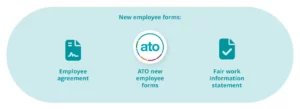Creating and agreeing upon new employee forms for onboarding staff is an essential (and often legal) requirement of all employers.
When you’ve made the decision to hire someone, what do you need to know about new employee forms and employee onboarding?

New employee forms
When onboarding a new employee into your organisation, you’ll need a range of new employee forms. Are you aware of what forms you’ll need?
Employee agreement
The first new employee form you’ll need will be your new employee agreement. An employee agreement is an essential document necessary for every new employee.
Each employee agreement needs to, at the very least, comply with the legal requirements laid out by the Australian Government, as stipulated by the Fair Work Ombudsman.
Why do you need an employee agreement?
Every employee needs to understand (and agree to) the demands of the organisation and the requirements of the role that they’re undertaking.
An employee agreement will clarify wages, role requirements, rights and what’s expected of the employee in exchange for remuneration.
An employee agreement usually includes (but is not limited to)
- Full employee details and contact information including bank details, TFN and emergency contacts.
- Title and details of the expectations of the role.
- Employer policies, including HR, privacy, social media, and work from home.
- Any necessary requirements of the role (driver’s license)
- Mode of employment, such as part time or full time, and the hours required.
- Place of employment, such as the primary address.
- Payment or remuneration details including wages, bonuses, overtime, and superannuation.
- Details of employee leave entitlements.
- Any protections of employer’s intellectual property or non-compete clauses.
- Employee termination and probation details.
- Visa requirements.
The employee agreement form can be extended on as desired by the organisation, within the constraints of the law.
Always check with Fair Work that your new employee agreement is lawful and complies with necessary information collection and dispersal.
Legal advice on drafting new employee contract is often sought by many employers (and is recommended).
ATO new employee forms
As for the Australian Tax Office, your new employee will have to fill out the below. These payroll and STP related forms are available online through the ATO and will link with your new employee’s MyGov account for ease and accuracy.
- tax file number declaration
- superannuation (super) standard choice
- withholding declaration
- Medicare levy variation declaration
Fair Work Information Statement
On top of ensuring that your new employee agreement conforms to the letter of the law, you’ll also need to provide your new employee with a Fair Work information Statement.
This statement includes awards, employee rights, termination rights and other information necessary for a new employee to understand how they can be legally treated and what recourse they have if they feel their employment rights have been violated.
This is a mandatory requirement of all employers.
Employee onboarding
Employee onboarding is a process of getting your new employee up to speed with their role and your organisation as well as getting your systems ready.
Employee onboarding is certainly not limited to forms and agreements.
Here’s a quick new employee onboarding checklist to ponder.
New employee checklist
Logistics
- Provide all new employee agreements, as above.
- Provide all equipment necessary for the role.
- Ensure passwords, logins and required systems and software are detailed and ready.
- Detail any access requirements and workplace rules.
- Assist in detailing close by shops, services, and transport.
- Outline your business’s layout and run through any facilities.
Company overview
- Give an overview of all employees and roles.
- Give overview of company history.
- Detail the organisation’s vision and goals.
- Give detail of your customers and intended market.
- Detail your products and services.
Role overview
- Provide extensive details of role responsibilities and goals.
- Ensure they have what they need to succeed.
- Map out direct reports and ‘chain of command’.
- Introduce them to colleagues and other employees, detailing their role and when to approach them for assistance.
Once you’ve laid out your new employee agreements, considered the Fair Work requirements and run through your new employee onboarding process and new employee checklist, you’re well on your way to welcoming a productive (and legal) new employee into your business.























